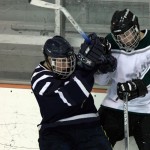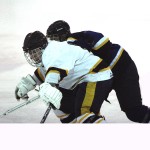A Pee Wee level coach was looking for help recently in a hockey forum. And, after noticing few others offered him anything that would really work, I decided to help here, troubleshooting the problem his kids seem to be having with their backchecking.
The young coach, Michael B, is from Wisconsin, and he says his players are mostly 12-years old.
-- Dennis Chighisola
Troubleshooting Hockey Backchecking
Whenever I try troubleshooting something long distance, I usually need to know a few things in order to get a better feel for the real problem/s. That in mind, I shot off these three questions to the young coach...
1) How much about backchecking do you think your kids truly know?
2) What have you done so far with them in this area?
3) What are the kids actually doing (wrong) in their games?
Michael answered back, noting that, "So far all I have been trying to get them to do is come back and attack the other team. In practice they do well. In games they tend to think the d will take care of it. They allow the other team to skate through with out much effort. When I ask , they all know what they have to do."
He continued by suggesting that his kids may be playing too much like individuals, rather than as a team.
He went on further offering, "I am going to try competitions during games to see who can take the most pucks away from the other team. I don't like encouraging (them) to play like loners, but it might work "
 I can tell from the way he explained things, that Michael likes his kids. Heck, the fact that he would ask for advice in an open hockey forum says a lot about how he cares for his kids.
I can tell from the way he explained things, that Michael likes his kids. Heck, the fact that he would ask for advice in an open hockey forum says a lot about how he cares for his kids.
As for his answers, the one thing that troubled me was that his kids might not have been drilled in backchecking basis. Said yet another way, I suspect few of his kids -- or even their parents -- would do more than stand with their mouths wide open if I asked them to define the term backchacking for me.
With all that, Coach B's last note to me explained part of the way he addresses backchecking, saying, "I tell my kids about the other team. If they can't shoot, they can't score. If they can't score, they can't win." And he closes with, "Someday they will put it all together."
Hmmmmmmm... Will they? Really?
To paraphrase my answer to that last paragraph... I just suggested that talking with the kids is only going to go so far. Oh, what he'd told them was right, and it was good stuff to share with a group of youngsters like his. If you think about what he said up there, though, there's not a lot his kids can hang their hats on. I mean, every player -- beginners through pros -- kinda knows those principles, and I'm betting that most of them try to score while also trying to keep their opponents off the scoreboard. But, do those words really guide them in HOW to prevent those enemy goals? I don't think so. (Oho, am I back on that "WHAT plus the HOW" thing again? Maybe.)
With all that, let me give my version, which I suspect is pretty close to what Michael is hoping for his kids. And, to begin, I think he has to talk to his kids about the definition of backchecking...
Up in the bleachers, parents are likely screaming on a turnover, "Backcheck! Backcheck! Backcheck!" If I'm right, what they really mean is for all the kids to skate their buns off coming back towards their own goal -- with no real guidelines, no real rules for what they're to next do...
If I had to define just about any phase of our game, I'd probably need an hour. Still, let's begin with the idea of the closest player to the opposition puckcarrier pressuring him as quickly as possible. Hey, if that works, we might stop the whole rush, and not need to backcheck at all. If it doesn't work, every player on our side has to in a hurry find an enemy player and stick with him. In today's (patty cake?) game it might not work, but I'll usually advise my checking forwards to bump their man upon first finding him, this to slow him a bit.
 As the opposition rush leaves our zone and moves through the neutral zone, it's kinda man-on-man, or everyone doing their part to help. Two backward skating defensemen would have the puckcarrier and the first open opponent, while our three forwards coming back would have the third attacker, the fourth, and the fifth. All the while our checkers should be moving close to shoulder-to-shoulder with their man (I explain that differently in another post), and in between their man and the puck. Through the neutral zone, things can be played rather loosely, and backcheckers can look to intercept passes.
As the opposition rush leaves our zone and moves through the neutral zone, it's kinda man-on-man, or everyone doing their part to help. Two backward skating defensemen would have the puckcarrier and the first open opponent, while our three forwards coming back would have the third attacker, the fourth, and the fifth. All the while our checkers should be moving close to shoulder-to-shoulder with their man (I explain that differently in another post), and in between their man and the puck. Through the neutral zone, things can be played rather loosely, and backcheckers can look to intercept passes.
Everything changes as the rush enters our defensive zone, though. This is the danger zone, or a lot like American footballers would say, the "red zone". From here onward, coverage must be tight. AND, from here onward, backcheckers moving towards their own net should look to control -- or negate -- their man's stick.
The latter should prevent passes from connecting. And, as play nears the net, checkers should continue controlling their man's stick to prevent tap-ins or rebounds.
When does backchecking end? It ends when the attack is over, and the puck moves away from the net.
Letting Michael B know that I'd be doing an article on troubleshooting hockey backchecking, I told him I'd leave him with one drill that might begin solving his kids' problems...
I told him to take three skaters (of similar color) and line them across the red line.
Put three more skaters (in different colors) lying on their bellies facing toward their net, and not able to see the three behind them.
On, "Go!", he should pass a puck to someone in the back row, and let them attack the net.
At the same time, the three on their bellies have to quickly rise and grab a man each. The challenge is for the backcheckers rising from the prone position to sort out who they can cover -- and not all chase the puck, and they should each stay with their man until the play is over.
When play gets close to the net, Michael should keep harping on the fact that, "Sticks score goals!" In other words, all the kids have to negate their man's stick, thus taking away passes and preventing rebound goals.
Asking the coach if that stuff was clear, he answered, "Makes perfect sense."
CoachChic.com members are lucky, in that I have a four-part video series included in this site, beginning with "Checking — The REAL Definition!", and continuing on with pretty in depth stuff on checking in the offensive zone, backchecking, defensive zone coverage, and so much more. There's also a pretty good post and video on "In hockey defense, know that 'Sticks Score Goals!'", that also includes a few good drills for perfecting that skill.
As for more drills... Michael and others should know that the drill I described up above can be adapted to be used in different areas of the ice. In other words, it could be adapted to help backchecking forwards find and cover their men in the offensive zone, and also from high in the offensive zone and through the neutral zone.
Lastly, I want to thank the young coach for offering me a chance to troubleshoot hockey backchecking for him and his kids. And I also want to offer further help should he need it. Actually, I'd love to field questions on this topic if others would just enter them in the comment boxes below.
PS: Although I've read somewhere that directing kids from the bench isn't a good idea, I beg to differ -- if only somewhat. I didn't yell all that much from my college team's bench, and I surely wouldn't as a pro coach (no one would hear, anyway). Kids in the developmental years are different, however, and they can be helped with short cues, or phrases that have real meaning behind them. So, my kids knew what I meant when I yelled the color of their opponents, as in "Get a red! Get a red!" No long directions, but just a simple cue my players understood to the letter.

No comments:
Post a Comment